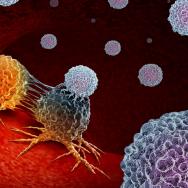Rhesus macaques don’t monkey around when it comes to HIV; they have a protein that effectively disables invading HIV particles.
A group of University of Chicago scientists announced an innovative study that explains how the macaques’ immune protein, called TRIM5α, works its magic. It also represents a significant step forward in the science of modeling how complex biological proteins assemble themselves, the scientists said.
“These proteins work together to encase the HIV capsid in a hexagonal net and restrict viral activity,” said postdoctoral fellow Alvin Yu and lead author of the study, which was published in Nature Communications.
It turns out that part of the secret appears to be defects—irregularities in the lattice net that allow the TRIM5α proteins the flexibility to encase any shape the invading virus takes.
Yu and Prof. Gregory Voth have been working to understand the physics underlying biological processes using computer simulations. But a simulation that actually represented every atom in an HIV virus can easily overwhelm even the largest supercomputers, so there’s a delicate methodology to picking which parts are vital to include in a simulation, and which can be safely pixelated out. This is called “coarse-graining."
They turned their attention to the mystery of the TRIM5α protein. Yu and Voth knew that TRIM5α could form two-dimensional lattices, but questions remained as to how the proteins collectively wrap around the three-dimensional capsid. So they ran simulations and modeled how the proteins interacted with each other as well as the invading virus, based on what is known from other experiments about its makeup.
The new models suggested several key points. One was that the protein uses an elaborate “hopping” mechanism to gradually accumulate atop the capsid until it reaches a tipping point. Then, as the lattice grows, the proteins squeeze together in such a way that irregularities start to appear in the lattice.
Careful experiments by their collaborators verified what they had seen in the model. Yu surmised that these irregularities are important so the monkey TRIM5α can adjust to differently shaped HIV capsules. “HIV capsids are notable for varying significantly in their structures—so these TRIM proteins also need the ability to adapt to their different structures,” Yu said.
A simulation shows how the proteins assemble themselves gradually into a net around the invading HIV capsid. (Illustration courtesy of Alvin Yu)
It’s also important how strongly the proteins bind to each other and the virus. “There’s also a fine balance in interactions between the protein and virus. The assembly of this lattice is a collective behavior that only occurs over very particular ranges of interaction strengths,” Yu explained.
Such knowledge may someday help inform treatments for HIV.
There are also implications for computing, Voth said: “This is a big step forward in technology for computer simulations of very large molecular systems. It really effectively represents more than a billion atoms, which you could never do with a study at full atomic resolution. It’s a revolution in that sense.”
The researchers used the Extreme Science and Engineering Discovery Environment Stampede2 at the Texas Advanced Computing Center, and the publication is a result of an ongoing collaboration between the Voth group and the labs of Owen Pornillos and Barbie K. Ganser-Pornillos at the University of Virginia.
Citation: “TRIM5α self-assembly and compartmentalization of the HIV-1 viral capsid.” Yu et al, Nature Communications, March 11, 2020. https://doi.org/10.1038/s41467-020-15106-1.
Funding: National Institutes of Health, National Science Foundation, Institute of Biophysical Dynamics at the University of Chicago

